广州初中英语语法分布预览2017.12.16
- 格式:pdf
- 大小:119.15 KB
- 文档页数:1
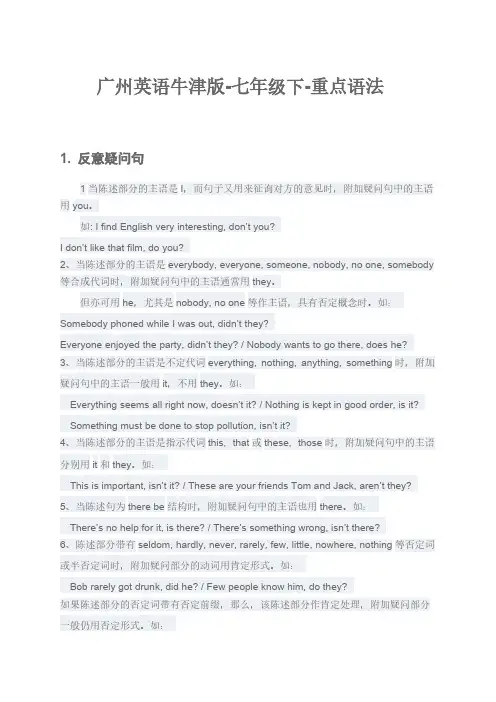

广州中考英语知识点代词是代替名词、形容词和数词的词。
按其意义、特征及其在句中的作用分为:人称代词、物主代词、指示代词、反身代词、相互代词、疑问代词、不定代词和关系代词等。
一. 人称代词1.人称代词的人称、数和格,如下表所示。
2.人称代词有主格和宾格之分。
通常主格作主语,宾格作宾语。
如:I like tabletennis. 作主语Do you know him?作宾语3.人称代词还可作表语。
作表语时用宾格。
如:---Whos isknocking at the door?---It’s me.4.人称代词在than之后与其他人或事物进行比较时,用主格和宾格都可以。
如:He is olderthan me.He is older than I am.二. 物主代词1.表示所有关系的代词叫物主代词。
物主代词分形容词性物主代词和名词性物主代词,如下表所示。
2. 形容词性物主代词的作用相当于形容词,可在句中作定语。
例如:Our teacheris coming to see us.Thisis her pencil-box.3. 名词性物主代词的作用相当于名词,在句中可用作主语、宾语和表语。
Our school ishere, and theirs is there.作主语--- Is thisEnglish-book yours? 作表语--- No. Mine is inmy bag.I've alreadyfinished my homework. Have you finished yours? 作宾语三. 指示代词指示代词包括:this,that,these,those。
1. this和these一般用来指在时间或空间上较近的事物或人,that和those则指时间和空间上较远的事物或人,例如:This isa pen and that is a pencil.We are busy these days.In those daysthe workers had a hard time.2. 有时that和those指前面讲到过的事物,this 和these则是指下面将要讲到的事物,例如:I had a cold. That'swhy I didn't come.What I want to sayis this ; pronunciation is very important in learning English.3. 有时为了避免重复提到的名词,常可用that或those代替,例如:Television sets made in Beijing are just as good as those madein Shanghai.4. this 在电话用语中代表自己,that 则代表对方。
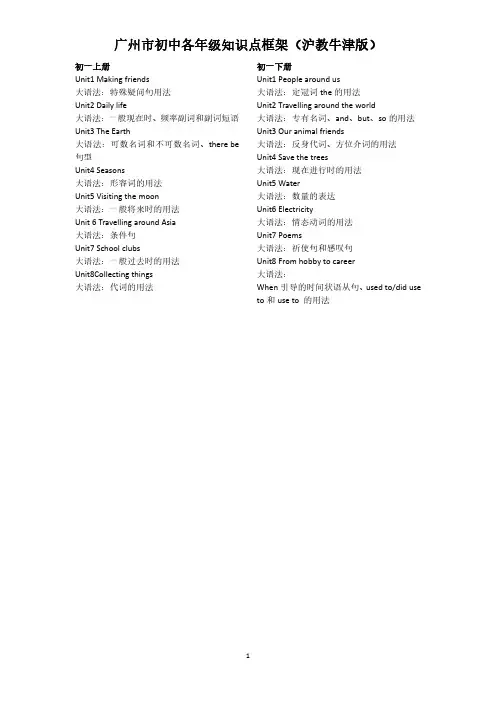
Unit1Making friends大语法:特殊疑问句用法Unit2Daily life大语法:一般现在时、频率副词和副词短语Unit3The Earth大语法:可数名词和不可数名词、there be 句型Unit4Seasons大语法:形容词的用法Unit5Visiting the moon大语法:一般将来时的用法Unit6Travelling around Asia大语法:条件句Unit7School clubs大语法:一般过去时的用法Unit8Collecting things大语法:代词的用法Unit1People around us大语法:定冠词the的用法Unit2Travelling around the world大语法:专有名词、and、but、so的用法Unit3Our animal friends大语法:反身代词、方位介词的用法Unit4Save the trees大语法:现在进行时的用法Unit5Water大语法:数量的表达Unit6Electricity大语法:情态动词的用法Unit7Poems大语法:祈使句和感叹句Unit8From hobby to career大语法:When引导的时间状语从句、used to/did use to和use to的用法Unit1Encyclopedia大语法:不定代词的用法Unit2Numbers大语法:数字的应用Unit3Computers大语法:形容词的比较级、最高级用法Unit4Inventions大语法:形容词的原级用法Unit5Educational exchanges大语法:现在完成时的用法IUnit6Ancient stories大语法:现在完成时的用法II及与一般过去式的对比Unit7Memory大语法:if和unless引导的条件句Unit8English week大语法:should、had better的用法Unit1Helping those in need大语法:代词不定时的用法Unit2Body language大语法:动名词的用法Unit3Traditional skills大语法:被动语态用法Unit4Cartoons and comic strips大语法:含情态动词的被动语态Unit5Save the endangered animals大语法:It is句型Unit6Pets大语法:副词的用法Unit7The Unknown world大语法:原因状语从句Unit8Life in the future大语法:过去进行时用法及与一般过去时的区别初三上册Unit1Wise man in history大语法:反义疑问句Unit2Great minds大语法:不定式的用法Unit3Family life大语法:主系表结构Unit4Problems and advice大语法:句子成分Unit5Action大语法:although和though引导的让步状语从句Unit6Healthy diet大语法:定语从句IUnit7The adventure of Tom Sawyer大语法:宾语从句Unit8Surprise endings大语法:定语从句II初三下册Unit1Great exploration大语法:结果状语从句及too..to/enough的用法Unit2Culture shock大语法:表示比较常见的形式Unit3The environment大语法:目的状语从句Unit4Natural disasters大语法:it做形式主语及it的相关用法Unit5Sport大语法:时态复习及被动语态复习Unit6Caring for your health大语法:宾语从句II。
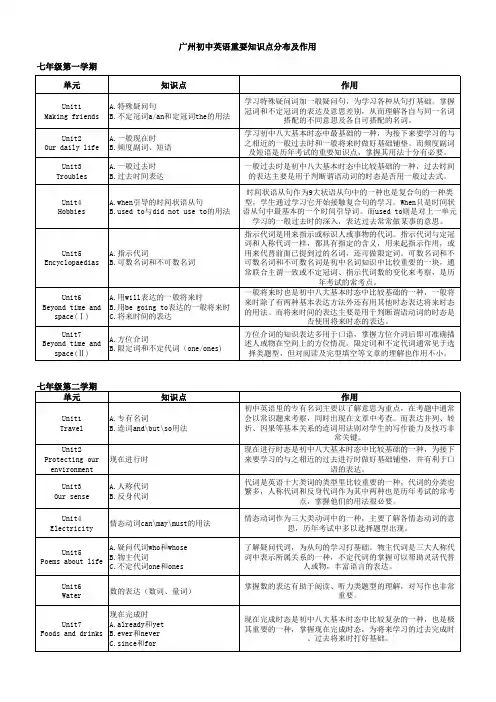
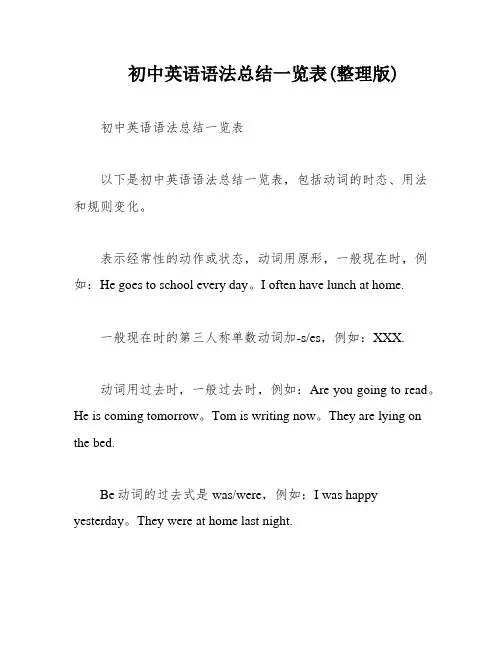
初中英语语法总结一览表(整理版)初中英语语法总结一览表以下是初中英语语法总结一览表,包括动词的时态、用法和规则变化。
表示经常性的动作或状态,动词用原形,一般现在时,例如:He goes to school every day。
I often have lunch at home.一般现在时的第三人称单数动词加-s/es,例如:XXX.动词用过去时,一般过去时,例如:Are you going to read。
He is coming tomorrow。
Tom is writing now。
They are lying on the bed.Be动词的过去式是was/were,例如:I was happy yesterday。
They were at home last night.表示将来要做的事情,用be going to + 动词原形或will/shall + 动词原形,例如:I am going to watch a movie tonight。
She will visit her XXX.表示经常性的动作或状态的时间词,例如:XXX等。
动词规则变化包括-s/es和以辅音字母+y结尾的变为-ies,例如:She studies hard every day。
They fly to New York every summer.表示过去某个时间内的动作或状态,用表过去的时间词,例如:XXX等。
动词规则变化包括以-e结尾的动词加-d,以辅音字母+y结尾的变为-ied,例如:XXX.表示此时此刻正在进行的动作或状态,用现在进行时(be+动词ing),例如:XXX to music now。
They are looking at the pictures.表示将来某个时间或某段时间内要进行的动作或状态,用现在进行时(be+动词ing),例如:I am XXX.表示过去某个时间正在进行的动作,用过去进行时(was/were+动词ing),例如:I was XXX XXX.表示过去某个时间已经完成的动作或状态,用过去完成时(had+动词过去分词),例如:I had XXX by the time she arrived。
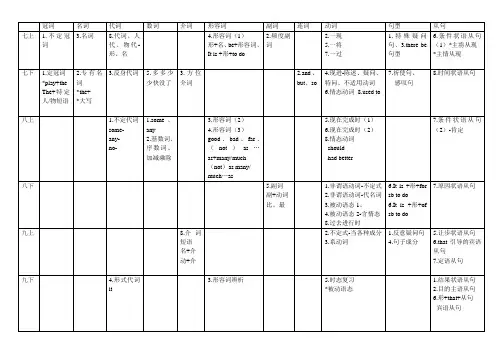
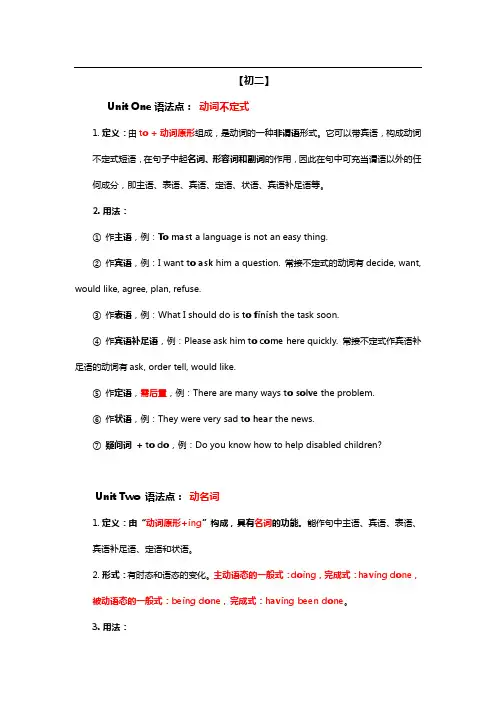
【初二】Unit One语法点:动词不定式1.定义:由to + 动词原形组成,是动词的一种非谓语形式。
它可以带宾语,构成动词不定式短语,在句子中起名词、形容词和副词的作用,因此在句中可充当谓语以外的任何成分,即主语、表语、宾语、定语、状语、宾语补足语等。
2.用法:①作主语,例:To mast a language is not an easy thing.②作宾语,例:I want to ask him a question. 常接不定式的动词有decide, want, would like, agree, plan, refuse.③作表语,例:What I should do is to finish the task soon.④作宾语补足语,例:Please ask him to come here quickly. 常接不定式作宾语补足语的动词有ask, order tell, would like.⑤作定语,需后置,例:There are many ways to solve the problem.⑥作状语,例:They were very sad to hear the news.⑦疑问词+ to do,例:Do you know how to help disabled children?Unit Two 语法点:动名词1.定义:由“动词原形+ing”构成,具有名词的功能。
能作句中主语、宾语、表语、宾语补足语、定语和状语。
2.形式:有时态和语态的变化。
主动语态的一般式:doing,完成式:having done,被动语态的一般式:being done,完成式:having been done。
3.用法:(1)作主语①谓语动词要用第三人称单数形式,例:Learning from others is important .②用it 作形式主语,把动名词置于句尾作真正的主语。
例:It no use waiting here.(2)作宾语①通常是在某些动词和短语后,常见的有:enjoy, consider, escape, avoid, admit,give up, risk, mind, imagine, delay, put off, insist on, be interested in, be good at, appreciate, finish, look forward to, suggest, allow, practise, can ’t help, excuse, feel like, keep on, pay attention to, succeed in.②既可接动名词又可接不定式的常用动词有:forget, remember, regret, mean, try,stop, go on 等,但表达的意义不同。
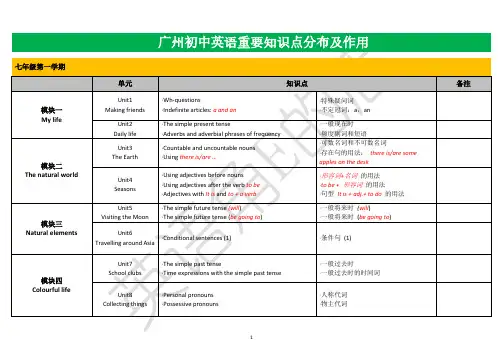
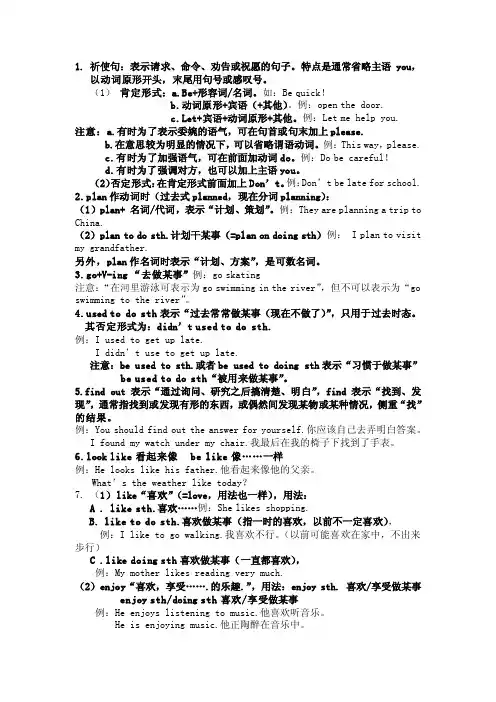
1.祈使句:表示请求、命令、劝告或祝愿的句子。
特点是通常省略主语you,以动词原形开头,末尾用句号或感叹号。
(1)肯定形式:a.Be+形容词/名词。
如:Be quick!b.动词原形+宾语(+其他)。
例:open the door.c.Let+宾语+动词原形+其他。
例:Let me help you.注意:a.有时为了表示委婉的语气,可在句首或句末加上please.b.在意思较为明显的情况下,可以省略谓语动词。
例:This way,please.c.有时为了加强语气,可在前面加动词do。
例:Do be careful!d.有时为了强调对方,也可以加上主语you。
(2)否定形式:在肯定形式前面加上Don’t。
例:Don’t be late for school.2.plan作动词时(过去式planned,现在分词planning):(1)plan+ 名词/代词,表示“计划、策划”。
例:They are planning a trip to China.(2)plan to do sth.计划干某事(=plan on doing sth)例: I plan to visit my grandfather.另外,plan作名词时表示“计划、方案”,是可数名词。
3.go+V-ing “去做某事”例:go skating注意:“在河里游泳可表示为go swimming in the river”,但不可以表示为“go swimming to the river”。
ed to do sth表示“过去常常做某事(现在不做了)”,只用于过去时态。
其否定形式为:didn’t used to do sth.例:I used to get up late.I didn’t use to get up late.注意:be used to sth.或者be used to doing sth表示“习惯于做某事”be used to do sth“被用来做某事”。
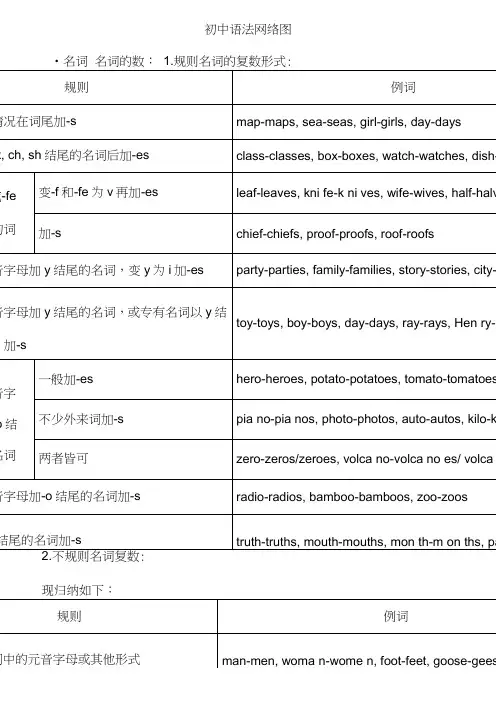
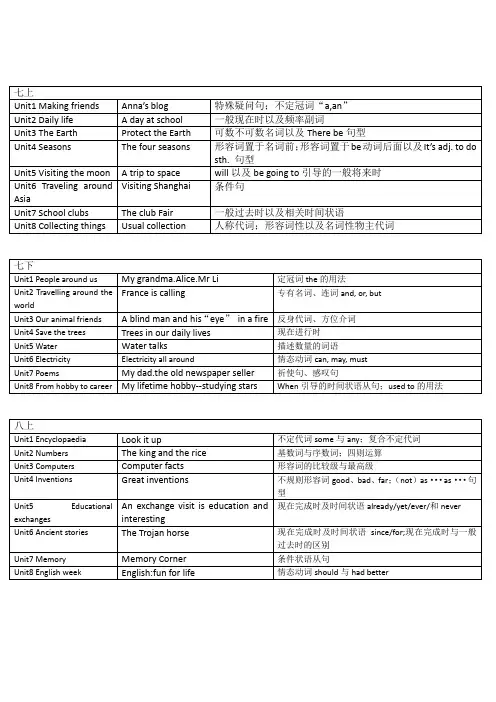
初中语法分布初一上册Starter unit1-31.26个字母的写法及读音。
2.what引导的特殊疑问句:what’s this in English? What color is it ? Unit 1 My name is Gina.1.be动词的一般现在时用法。
2.what引导的特殊疑问句。
3.形容词性物主代词my, your, his, her的用法。
Unit 2 This is my sister .1.人称代词I, he, she, they的用法。
2.指示代词this,that,these,those的用法3.who引导的特殊疑问句。
Unit 3 Is this your pencil ?1.名词性物主代词mine, yours, his, hers的用法。
2.含有be动词的一般疑问句的用法。
Unit 4 Where’s my schoolbag ?1.where引导的特殊疑问句。
2.方位介词on,in,under的用法。
3.连词and的用法。
Unit 5 Do you have a soccer ball ?1.have的一般现在时的用法。
2.一般现在时态肯定句和否定句。
3.连词and的用法。
Unit 6 Do you like bananas ?1.可数与不可数名词。
2.动词like的一般现在时的用法。
Unit 7 How much are these socks ?1.how much的用法。
2.基数词的构成及用法。
Unit 8 When is your birthday ?1.when引导的特殊疑问句。
2.名词所有格’s的用法。
Unit 9 My favorite subject is science1.what, why, who, when引导的特殊疑问句。
初一下册Unit 1 Can you play the guitar ?1.情态动词can的用法及一般疑问句2.what + questionsUnit 2 What time do you go to school ?1.频度副词:usually, always , never , hardly2.what time/ when + questionsUnit 3 How do you get to school ?how / how long / how far引导的特殊疑问句。